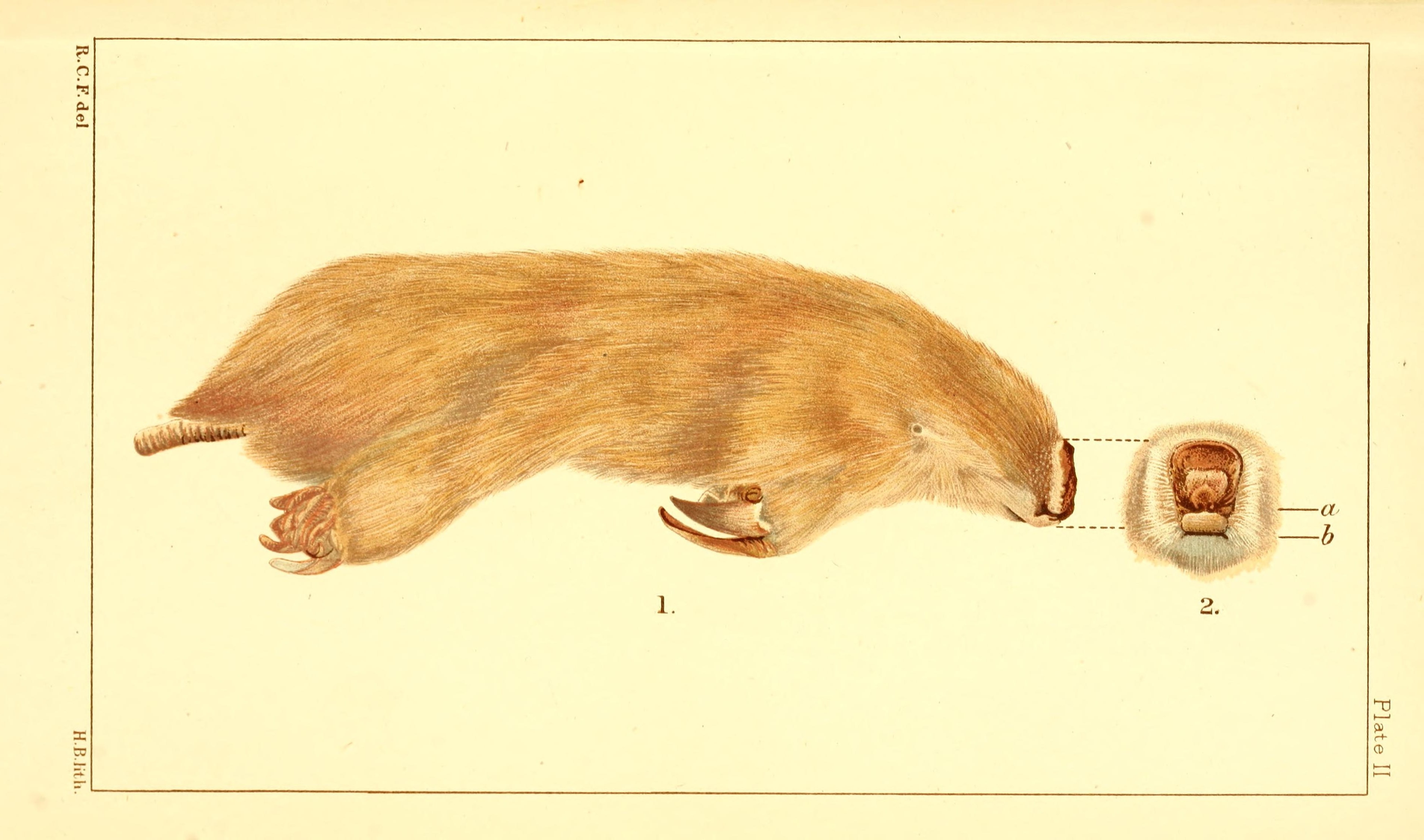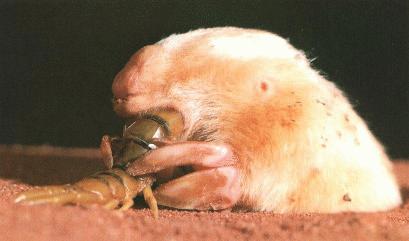Along with being great pets most of the time, desert animals can be among some of the weirdest animals on the planet. We are used to things that live on our surface world. It is all to easy to forget that there are creatures dwelling in areas in which humans cannot reasonably function. Specifically, humans are visual creatures, so when we see creatures that live in a lightless environment, they have an unsettling effect on us.

Except that one. That one's cute.
Meet the Marsupial Mole. Like most marsupials, they are native to Australia (specifically the arid deserts). Most of their time is spent underground, where they do almost everything. They eat beetle larvae and caterpillars in the wild, and have been observed eating spiders and lizards in captivity as well. There are two varieties (Notoryctes typhlops and Notoryctes caurinus), both being the only extant members of the family Noryctidae.
Marsupial moles are probably one of the weirdest examples of convergent evolution ever. They diverged from the main marsupial family at about the same time as the dinosaurs went extinct. In the meantime, they have evolved to look a lot like moles mixed with Weasel Balls. They have the same reduced eyes and spaded paws as normal moles. Otherwise, they deserve to be on the "cutest marsupial" list alongside koalas and numbats.
Marsupial moles are perfectly adapted to the deserts of Australia. They mate, eat, and do presumably everything else underground. Their eyes are just lenses beneath fur, making them completely blind, and they lack cute mammalian ears. Like naked mole rats, they are effectively ectothermic mammals. They are the only mammal species in which the neck vertebrae are fused to the back of the head to provide more force when digging. They do not even require much oxygen; despite being mammals, their requirements are so minimal that the oxygen that seeps through the sand will suffice. They are so ill-adept at being on the surface that their floundering underground is reduced to an awkward waddle as soon as they leave the sand.
Living underground all the time unfortunately means that we know almost nothing about these weird marsupials. Tunnels are extremely common; it's the actual moles that are hard to find. They can be bred in captivity, but even then, that tells us nothing about numbers in the wild. It is suspected that these furry little critters are more common than once thought, but because they are hard to record, they are Endangered on the basis of being data deficient.

The Aborigines were aware of these weird little animate cat toys as well. The Southern Marsupial mole is called Itjaritjari, which sounds a whole lot cuter than comparing it to a mole. On a tangentially-related note, we have no idea what Nintendo would call this if it ever got made into a Pokemon.

Except that one. That one's cute.
Meet the Marsupial Mole. Like most marsupials, they are native to Australia (specifically the arid deserts). Most of their time is spent underground, where they do almost everything. They eat beetle larvae and caterpillars in the wild, and have been observed eating spiders and lizards in captivity as well. There are two varieties (Notoryctes typhlops and Notoryctes caurinus), both being the only extant members of the family Noryctidae.
Marsupial moles are probably one of the weirdest examples of convergent evolution ever. They diverged from the main marsupial family at about the same time as the dinosaurs went extinct. In the meantime, they have evolved to look a lot like moles mixed with Weasel Balls. They have the same reduced eyes and spaded paws as normal moles. Otherwise, they deserve to be on the "cutest marsupial" list alongside koalas and numbats.
 |
| Still kinda cute. |
Marsupial moles are perfectly adapted to the deserts of Australia. They mate, eat, and do presumably everything else underground. Their eyes are just lenses beneath fur, making them completely blind, and they lack cute mammalian ears. Like naked mole rats, they are effectively ectothermic mammals. They are the only mammal species in which the neck vertebrae are fused to the back of the head to provide more force when digging. They do not even require much oxygen; despite being mammals, their requirements are so minimal that the oxygen that seeps through the sand will suffice. They are so ill-adept at being on the surface that their floundering underground is reduced to an awkward waddle as soon as they leave the sand.
Living underground all the time unfortunately means that we know almost nothing about these weird marsupials. Tunnels are extremely common; it's the actual moles that are hard to find. They can be bred in captivity, but even then, that tells us nothing about numbers in the wild. It is suspected that these furry little critters are more common than once thought, but because they are hard to record, they are Endangered on the basis of being data deficient.

The Aborigines were aware of these weird little animate cat toys as well. The Southern Marsupial mole is called Itjaritjari, which sounds a whole lot cuter than comparing it to a mole. On a tangentially-related note, we have no idea what Nintendo would call this if it ever got made into a Pokemon.



No comments:
Post a Comment